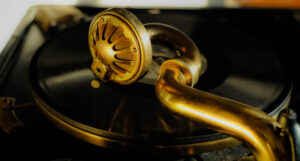
Yesterday Dad was listening to songs by Marty Robbins on a tablet I keep in his room. He shared with me how much he was enjoying the music by saying, “I can sit here and go with him.” Marty and his ballads have been favorites in Dad’s music collection since I was a child. Dad was telling me that the songs were familiar, that he was listening to the lyrics, and that he was imagining himself in the musical stories. It was great to hear this. Dad’s appreciation of music, recognition of artists, and ability to play records by himself has changed dramatically in the past nine months. This isn’t the first time Lewy Body Dementia has affected our music experience. Read the post “Just a Lil Bit Country.”
Dad no longer requests artists by name even if I give him a choice of just two. He rather quickly lost his ability to operate his favorite modern turntable. He began to think he had placed a record to play when there was nothing on the machine. When he did get something playing, he worried that playing the records would lead to him losing them or breaking them and he would turn it off again. A reasonable understanding might be that this was his way of expressing his own awareness about his loss of these abilities. We never know for certain. I decided to make a change when I walked in Dad’s room, and he was trying to put a cardboard album cover on his foot like a shoe and stand up in it. I gradually removed a few albums at a time. Dad didn’t notice they were missing. Of course, the records and album covers were all mismatched. Eventually, I removed the turntable completely. I replaced it with a tablet where I can load a variety of music apps. I particularly like the voice activated ones. Dad likes the ones with lyrics that scroll while the song is playing. At first he read and sang along. Now he just looks at the words and smiles. He can’t keep up any longer but likes that they are there.
The artist that remained the longest was Alan Jackson. Dad recognized his Precious Memories Collection by the image of the church on the album art. Each time I selected this music, Dad would tell me how he was there at the church with Alan when he recorded the songs. This delusion has also since faded. His music experiences are now only in the moment.
On the fourth of July, we played John Philip Sousa’s Stars and Stripes Forever on Dad’s 1920s Victrola Phonograph. Dad waved his arm as if conducting the orchestra through the entire recording. Last week we played Gene Autry. While singing along with “Home on the Range,” Dad swayed left and right, closed his eyes, and sang the chorus. Whether Dad is riding out on the range with Gene, at church with Alan, or on the streets of Laredo with Marty, he is happy in these moments. Music is no longer an independent past time for Dad. It’s okay. We have been listening to these songs together for as long as we both can remember. Wherever he goes in his mind, “I can sit here and go with him.”

